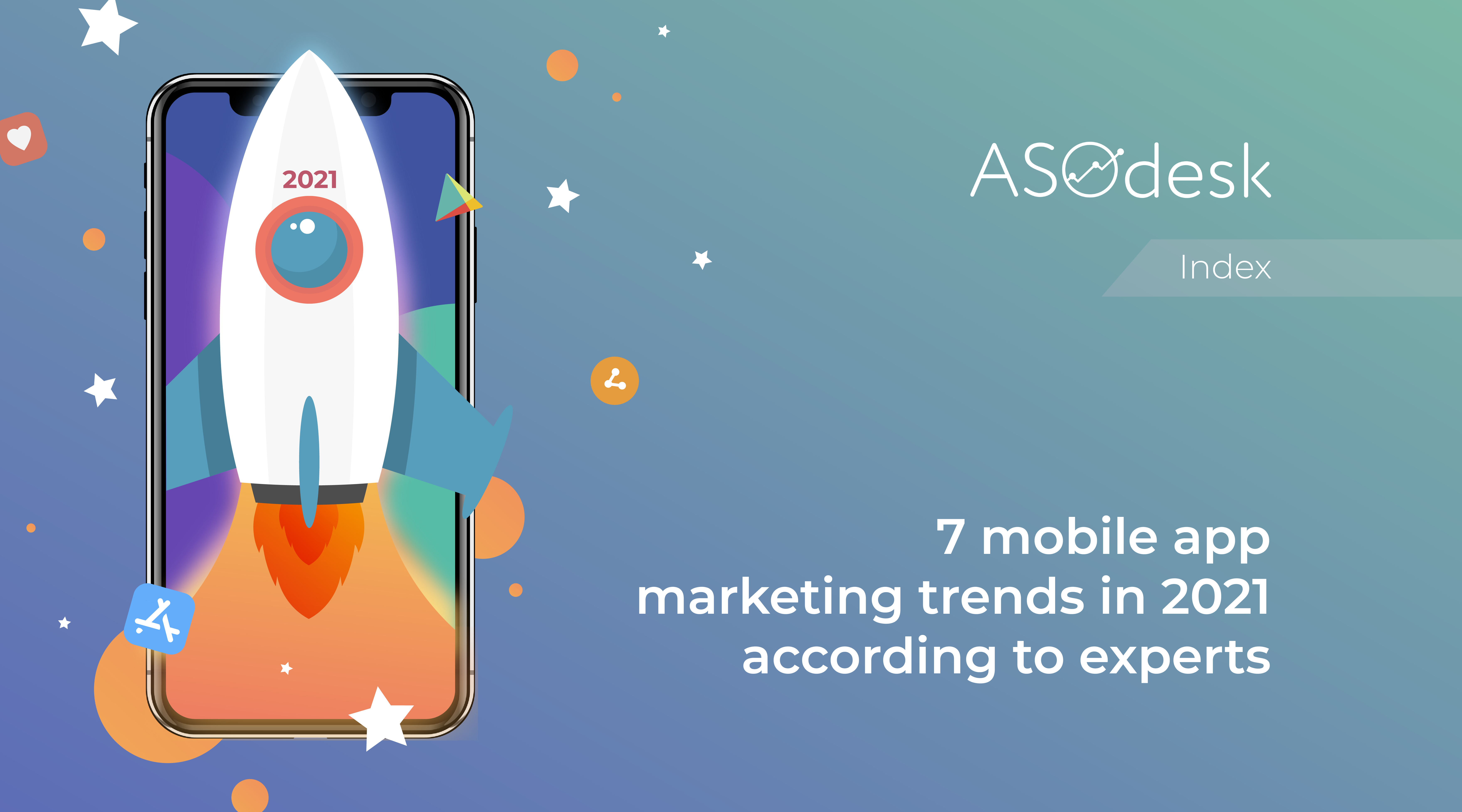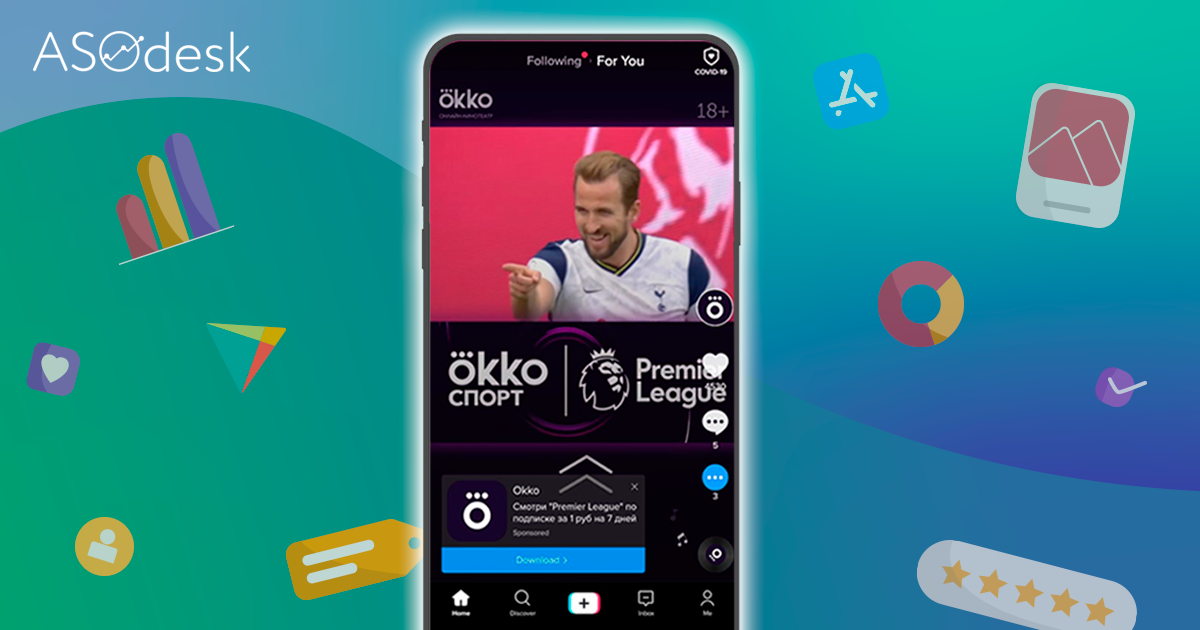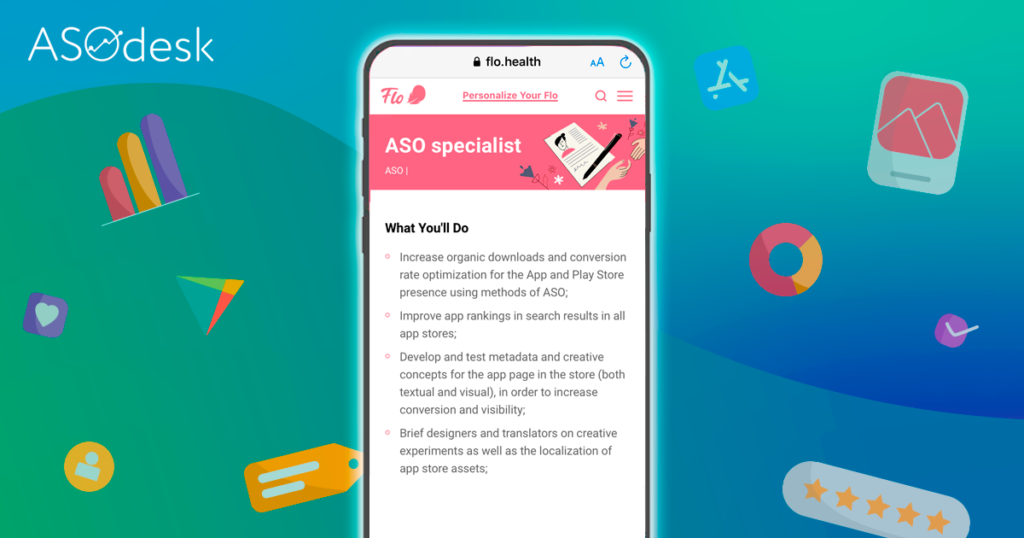7 mobile app marketing trends in 2021 according to experts

Thomas Petit (Independent App Growth Consultant), Peter Fodor (AppAgent), Simon Thillay (AppTweak) and others told the world what mobile marketers should prepare for in 2021. Experts predicted changes in App Store indexing, the consequences of the cancellation of IDFA, the impact of ASO on the product, and acceleration of monetization.
There have been many events in 2020 that have influenced mobile app publishers and marketers. In 2021, there will be even more changes, such as alterations in the algorithms and principles of the App Store. The new IDFA tracking policy will affect all promotion channels, including advertising, ASO, and ASA.
The mobile app market is becoming more and more competitive. App Annie predicts that mobile ad spend will jump to $290 billion in 2021.
To understand how to prepare for the change and promote apps in an increasingly competitive environment ASOdesk asked popular mobile marketers, consultants, and ASO specialists: Thomas Petit (world-renowned Mobile Marketing Expert), Peter Fodor (founder of AppAgent), Simon Thillay (Head of ASO, AppTweak), Maria Chernoplekova (ASO specialist, ASOdesk) and other experts told us about mobile app marketing trends in 2021.
1. We will need to invest in alternative promotion channels

In 2021, it is not enough to promote only through the App Store, Google Play and use standard advertising channels (such as Facebook and Google). To attract your audience and get more installs, you need to use alternative advertising platforms and app stores (Mac Store, App Gallery). It is important to invest in the audience and create a community around the application: invest in SMM, email marketing, website.

Thomas Petit, a world-renowned mobile marketing thought leader and independent app growth consultant

At first there was a heavy concentration in network, with the duopoly controlling a majority market share of dollars spent, while SDK ad networks and DSP were merging.
We’ve seen the emergence of alternative acquisition channels in secondary social channels (Snapchat at first, then TikTok lately which is growing much faster than the market) as well as less trackable channels, in particular with the establishment of influencer marketing as a viable acquisition strategy — as opposed to the usual app ads.
The big shakeup coming in 2021 may not be around the marketing mix structure, but measurement, and how developers approach evaluating the efficiency of their budget. Forced by a blunt move from Apple, I believe marketers are about to get smarter and realize how they’ve fooled themselves from the last click — a supposedly deterministic attribution in the past.
Don’t rely solely on paid acquisition. Paid UA should be a growth multiplier, but when used as the sole driver, it’s a dangerous game doomed to peak at some point. Invest in your own audience (community, social, email, web).

Ekaterina Gladkova, Communication Director, Go Mobile

In our agency the recommendation of new channels has become a normal thing lately. We advise advertisers to come to unexpected sites with creatives carefully tailored for them. This will help you reach a new audience, build knowledge among those who you have not been able to reach before, and be remembered for your own communication. Examples: TikTok and Likee with Gen Z communication, Tinder and Badoo with dating creatives, or even Pornhub with thematic texts.

Anastasia Lichnaya, Lead ASO Manager, Belka Games

The arrival of the Mac App Store will not most likely affect 2021. The devices on which it is installed will not be massively updated so quickly, but it is worth watching and trying how it works. And if the application has the opportunity to appear there, it will have a positive effect on any kind of traffic. Therefore, it is worth starting to look in this direction. Learn how you can promote in the Mac Store, what competitors are doing here. It will benefit you if you start developing in the Mac Store earlier.

Lina Danilchik, Marketing Manager and Mobile Application Development Expert, SplitMetrics

To win in the difficult struggle for a user in 2021, you need to adapt to constant changes in the market: look for non-standard solutions and new channels for attracting users (because many familiar ones will no longer be effective), such as Apple Search Ads, TikTok, until your competitor come there; and at the same time you should integrate traditional marketing channels like email, web into your mobile strategy.

Maria Chernoplyokova, ASO specialist, ASOdesk

Huawei is actively promoting its own app store — App Gallery. Now the competition for top places in the search results in the App Gallery is lower than that of the App Store and Google Play, since not all developers have paid their attention to the new store and adapted their applications to the requirements of Huawei (especially often difficulties are caused by the requirement that there are no built-in Google services).
App Gallery is used by over 490 million people, and in terms of the number of smartphones sold worldwide, Huawei ranks second after Samsung. Therefore, publishing an app in the App Gallery can bring developers a large number of installs and new audience.
2. There will be global changes due to changes in the IDFA rules

IDFA is a unique number that helps associate app installs with a specific number and ad campaign. The developer should place all information about the tracked data on the application page. In an update to the iOS expected in 2021 tracking IDFA will require user permission. We may hear about new tactics for collecting information. Platforms with their own data will develop. Marketers will measure ROI differently. Targeted ads can get cheaper, and Apple Search Ads (ASA) can get more expensive. The role of ASO will increase.

Peter Fodor, the Founder & CEO of AppAgent

However, the changes in user tracking related with IDFA depreciation will fundamentally influence how performance marketing works. Apple miserably fails with communication around SKAdnetwork, providing clear evidence and support for the upcoming tectonic shift in the industry.
The role of MMPs will change, the way how we evaluate the ROI of campaigns will change, but no one actually knows what will really happen even six months after the original announcement at WWDC in June.
The IDFA depreciation will only increase the pressure to experiment with the media mix and increase monetization, so marketers can afford less traditional channels and experimentation.

Simon Thillay, Head of ASO, AppTweak

As iOS is a far more profitable platform than Google Play for most app developers, the loss of IDFA, once ATT comes into effect, is going to be the dominant story of at least the first half of the year.
This also leads to the second change, which is going to be the search for new and/or “alternative” data. Marketing tools relying on probabilistic models, and/or “softer” signals that can shed light on customer behavior, are going to gain traction while also being all the more scrutinized for the quality of their data.
I expect we’ll hear about many “hacks” and new “tactics” in 2021, with only a limited amount backing their claims with data and potential for application to more than just a few apps. My prediction is that the best new methods will rely on adjustments from already known practices, rather than groundbreaking techniques.

Lina Danilchik, Marketing and PR Manager, SplitMetrics

The cancellation of IDFA will entail a whole series of changes: Apple Search Ads (ASA) will be almost the only channel on iOS where you can show ads to users who have not given their consent to track their mobile activity. Facebook traffic will drop in price due to restrictions that will appear. The role of ASO in app stores will increase.
The conversion to installs will be affected by the fact that now users will see what data the app publisher is requesting right on the product page. To understand how this innovation will affect the conversion of your application, you need to conduct A/B testing: test a version of the page with a different number of user data requested by the application. To do this you can use a tool like SplitMetrics.

Alina Romanova, Head of ASO, Go Mobile

The innovation will be a powerful driver for the development of new technologies for tracking user data. All platforms with their own data will acquire additional relevance: DSP, SSP, DMP.
Another trend is to motivate users not to disable IDFA for a specific application and offer benefits to those who agree to track the ID.

Maria Chernoplyokova, ASO Specialist, ASOdesk

In fact, not many users care about what data the app collects. Fewer still read the privacy policy before accepting it. Nowadays, attention to personal data is increasing. However, I will assume that on a global scale, we will not see strong changes in the near future. Most users are likely to continue to provide IDFA tracking access.
On the other hand, it is necessary to take measures now so that users are inclined to trust the application and give access to IDFA. Developers can talk about the benefits and security of IDFA in the application description or on onboarding, provide certain bonuses for consent to tracking.
If IDFA abandonment poses a global threat to advertising performance, application developers may issue a series of articles explaining the safety and benefits for users who agree to track IDFA. Tracking personal data is now perceived by some users as a threat, so it takes a lot of resources and time to at least slightly change public opinion in a positive direction.
We regularly publish useful articles on ASO and mobile app marketing and review the latest news from the App Store and Google Play. Subscribe to our newsletter and never miss out on these useful materials!
3. The importance of product improvement and brand promotion will increase

Experts recommend investing in product improvement and brand development. In 2021, the role of the brand in the mobile market will increase. It will take a lot of effort to get attention to your product after the IDFA tracking policy changes. Therefore, it is important to add new features to the application, work on the quality of advertising messages, implement automation and apply new metrics to track ad performance.

Simon Thillay, Head of ASO, AppTweak

The fundamentals for getting more installs have not changed: beating your competition is about a combination of delivering a quality product, communicating a clear message, and identifying the intents and needs of your customers. Never forget to study signals about how your product is perceived for each of these 3 pillars before launching new tests or operations, as too many apps seem to test and iterate for the sake of it, and forget to consider what they’ve learned and should aim to improve.
Marketers will aim to improve their performance for “Limit Ad Tracking” audiences, which they will mostly do by focusing more on messaging and brand positioning. What will be particularly interesting is how this will affect both paid and organic, who will have to work closer together.

Peter Fodor, Founder & Chief Marketing Agent of AppAgent

My single most important recommendation is to focus on improving your product and the value it delivers, which eventually results in better monetization. Advice for marketers specifically would be to start thinking about your app as a brand. Otherwise, it will be perceived as a commodity by users and you can’t win the battle if you are not differentiating enough.

Daria Pavlyuk, Head of ASO, ZiMAD

Users will become even more demanding as almost any application will have to adapt to 5G technologies and completely new speeds — without overheating devices, freezing, and other things. Nobody likes it when an application runs slower than the person does.

Anton Afanasyev, Performance Director, Mobio

To win the competition in 2021 you need to:
1. Adapt and improve the product through a comprehensive analysis of the market and competitive environment.
2. Periodically reevaluate the unit economics of the product, switch to alternative evaluation metrics and their additional accounting.
3. Search for new channels to attract traffic or new audiences.
4. Implement automation processes. The one who does not run but goes today tomorrow will be the second. Therefore, the automation of processes and acceleration of work contributes to a multiple increase in productivity and, as a result, the economy.

Maria Chernoplyokova, ASO Specialist, ASOdesk

On Google Play, applications with lower weight gain advantage, because now the data about the weight of the application is displayed at the very top of the page. The lower the weight of the application is, the more users will decide to install it.
A card with a list of data collected for analytics, advertising, and product personalization has appeared in the App Store. Now users can compare applications with each other according to the criterion of data access and refuse to install applications that collect suspiciously a lot of information.
The listed parameters of the competitive advantage of an application are just one of many that should be taken into account when developing and promoting an application.
The most important parameter is a quality product, which is an integral and most important part of the success of promoting and developing an app or brand. If you invest millions in ASO or any type of ad that leads to an app with bugs and crashes, your expenses will not only not pay off, but may also take the app to the bottom of the search results due to an increase in negative reviews and the number of app uninstallations after installation.
First of all, you need to make sure that most of the resources are spent on maintaining and improving the quality of the application, its development and the introduction of new technologies.
4. We should prepare for changes in the App Store indexing

Auto-correction strongly affects search results and limits the use of branded queries in the semantic core. The appearance of the new Apple search engine may affect the indexing of the application for various queries in the App Store.

Daria Pavlyuk, Head of ASO, ZiMAD

I think app publishers need to follow frequently changing trends for keywords in the App Store: Apple tightens the screws on what can be a key and what is not, and can easily pessimize you for a good key which you will not check in the mobile trademark database on time.

Altai Zeynalov, ASO expert, founder and head of Diveo Media

Note that Apple is about to launch its own search engine and refuse from Google. A whole team of engineers is working there now. I think 2021 may change something in indexing.

Anastasia Lichnaya, ASO Lead, Belka Games

Auto-correction appeared in iOS, due to which the conversion decreased, as some requests began to be incorrectly corrected. We received an increase in impressions for these requests, but the conversion decreased. It is important to understand which requests stopped giving traffic and exclude them from the semantic core.

Maria Chernoplyokova, ASO Specialist, ASOdesk

Among the latest global changes in App Store indexing is the introduction of auto-correction. Now there is no point in adding misspelled names of large brands to the semantic core in order to take away some of their traffic. You should also pay attention to auto-correction of keys with diacritics. Each localization and diacritic has its own rules. In iOS 14, you should check not only the key traffic, but also how the search algorithm interacts with it. It is necessary to constantly monitor ASO news in order to timely edit the metadata in the App Store.
5. Subscriptions will be used more often for monetization and engagement

App publishers will work to increase customer engagement. Limiting Apple’s attribution structure could lead to earlier monetization. More companies can start using bundled subscriptions to make their pricing models more attractive.

Thomas Petit, a world-renowned Mobile Marketing Expert and independent App Growth Consultant

2020 has seen a tremendous increase in app usage due to externalities, at least for most verticals, but purchase behaviors haven’t followed the same trend.
With limitations around remarketing in 2021, as well as a growing maturity of users regarding app quality, I expect developers to double down on their lifecycle strategies to push engagement rates and retain more demanding everyday users.
I’m slightly concerned that Apple attribution framework limitations may push developers to force monetization earlier, to be able to gauge high-intent users from day 0, which isn’t necessarily in the best interest of user experiences. With that said, putting more attention on activation and onboarding is rarely a bad idea.

Peter Fodor, Founder & Chief Marketing Agent of AppAgent

I see two other interesting trends worth mentioning: the convergence of subscriptions and in-app purchases in the pursuit of higher LTV of users, and the need to go beyond direct response channels if your company wants to continue the growth trajectory in the long-term.

Simon Thillay, Head of ASO, AppTweak

Subscription-based revenues have been the most profitable business model but are increasingly leading to subscription fatigue, and more businesses might start turning to subscription bundling as a way to keep their models attractive. Games, on the other hand, remain heavily reliant on freemium models.

Maria Chernoplyokova, ASO Specialist, ASOdesk

The App Store and Google Play prefer to promote apps that use a subscription model, because the companies themselves receive a percentage of the developer’s profit in this model. First of all, let’s recall the removal of the Fortnite game from the App Store, the developers of which announced the possibility of in-app purchases bypassing Apple. This decision resulted in loss of audience and finance for Riot.
The latest update on Google Play also proves the fact that paid apps are being promoted. Apps in search results can now be filtered by several parameters, among which there is an option to view only paid apps. At the same time, you will not be able to view only free applications. Thus, for the app to be better promoted by Apple and Google, a subscription fee should be added to it.
6. The impact of visual optimization on app promotion will increase

New trends in visual optimization are emerging, publishers are testing ad creatives on icons, screenshots and in games. Every year more and more users start to scroll to the end of the application page, so all elements of the application page will affect the user’s perception of the application. Visual optimization increases conversions by 17-24%.

Anastasia Lichnaya, ASO Lead, Belka Games

Applications can compete by a showcase, a graphic part, that is, by increasing conversions. Publishers need to drive the most relevant traffic and show the benefits of an app or game on a page. The showcase should reflect the essence of the application as much as possible in order to attract relevant traffic, a high-quality user.

Daria Pavlyuk, Head of ASO, ZiMAD

Minimalism is gaining momentum on the graphical part of the landing: publishers are striving to clearly define what their application can boast of, since it no longer makes sense to focus on standard functions due to the strong growth of competition.
More and more companies, starting from mid-2020, began to test the advertising part of their creatives on icons and screenshots. And some have even added similar mechanics to the game. For example, a puzzle mechanic was added to the Austin game where you need to release a creature. The more competitors appear in one niche genre, the more flexible developers have to be when selecting features for soft launch and subsequent global release.

Lina Danilchik, Marketing and PR Manager, SplitMetrics

According to SplitMetrics research and our recently released ASO benchmarks and trends report, in 2020, App Store users scrolled only 20% of the product page, while on Google Play, most users scrolled over 60% of the page. This is because user behavior varies across app stores. At the same time, this indicator has improved for both the App Store and Google Play compared to 2018. People study more app store pages, which means they need to spend more time designing them.
The key elements influencing conversion are visuals. In the App Store, these are an icon (up to 22.8% increase in conversion after optimization), screenshots (up to 21.7% increase in conversion after optimization) and videos (up to 16.6% increase in conversion after optimization).
On Google Play, the layout is about the same, but in the first place — screenshots (up to 24.3% increase in conversion after optimization), an icon (up to 20.2% increase in conversion after optimization), video (up to 17.4% increase in conversion after optimization).
We need to be especially careful with videos: for many of our clients, adding a video not only did not help, but negatively affected the conversion, so we need to test. When developing visual elements and forming hypotheses for testing, it is worth relying on neurobiological data, for example, I described the relevant recommendations here.

Maria Chernoplyokova, ASO Specialist, ASOdesk

Visual optimization trends are different for games and applications. While apps tend to be minimal, games, on the other hand, draw users in with a lot of detail and a vivid picture. Trends are traditionally white and black, as well as various shades of blue. We will tell you more about the trends of 2021 in an article that will be released soon on the ASOdesk blog.
By the way, pay attention to the colors of 2021 according to Pantone — Ultimate Gray and Illuminating yellow. In 2020, Pantone relied on the classic blue color and paid off.
Visual optimization must be in line with trends and at the same time stand out from the competition. The most important thing is that the optimization is based on real numbers, and not on personal preferences and tastes. It is necessary to conduct A / B tests in order to find exactly those options and combinations of visuals that will really attract a new audience and increase the conversion to install.
7. ASO will have more impact on the product

More mobile marketing professionals will participate in ASO. ASO will have a much stronger impact on product and mobile app marketing. The demand for the services of ASO specialists will grow, and there will be a need to create ASO departments within companies.

Thomas Petit, a world-renowned Mobile Marketing Expert and independent App Growth Consultant

ASO has matured from a keyword & hacks based obscure discipline, to a must-have, holistic activity that involves many teams. I expect its importance to keep growing with organizations, especially among the bigger ones, and possibly to merge and be renamed as “organic growth”, in order to differentiate from the early days of ASO. Read more.

Simon Thilay, Head of ASO, AppTweak

In the largest mobile markets, ASO has already become both a requirement and a marketing factor that is not sufficient to fuel fast growth, but I expect app marketers will now return to this fundamental to leverage ASO data and get a better understanding of customer expectations and market trends. More people will start looking at ASO from a holistic point of view and stop considering it as a growth hack, to value its position rather at the crossroads between marketing and product.
In terms of what publishers should prepare for, I’m expecting the App Store to grow even more into a “media platform”, in which apps compete for discoverability, while it’s possible the Play Store might aim to add new user signals to its algorithms. Marketers’ roles will require a larger funnel approach, from aligning messages between first touchpoints to giving more attention to retention and customer feedback.

Maria Chernoplyokova, ASO Specialist, ASOdesk

Despite the fact that ASO remains a highly specialized field, its impact on business is growing. Mobile app revenue is already a significant share of total revenue for many large companies. Self-isolation, which is accompanied by the closure of offline points of sale, had a particularly strong impact on sales in mobile applications.
Currently, about 9 out of 10 major brands have no ASO action. Although ASO has been around since the emergence of mobile app stores, there is still a lack of awareness in the market about the need for optimization and the competitive advantage that ASO has to offer.
Many articles are published on the ASO topic every day, courses are held. I am confident that such actions will soon bring a positive result in terms of business awareness of ASO technology, which can make a business more successful and profitable.
I believe the demand for the services of ASO specialists and agencies will grow. At the same time, business owners and application development agencies will attend to the creation of ASO departments within companies.
Conclusion
We interviewed 11 well-known marketers, executives and mobile professionals to find out the trends in mobile app promotion. In this article, we have highlighted the trends which the experts agreed on. Based on the events of 2020 and the opinion of professionals, we will provide mobile marketers and app publishers with recommendations for 2021:
1. Try new and non-standard platforms for app promotion, as there will be few standard channels to attract your audience. Use TikTok, consider posting on the Mac Store and App Gallery.
2. Adapt to changes in IDFA policy. Consider how you can convince users to provide access to the data you need.
3. Work on the quality and functions of applications, this is especially important in case of growing competition, development of 5G technologies. Develop your brand, so it will be easier for you to work with a loyal audience without any help of advertising.
4. Follow the App Store indexing changes. Remove those queries that stopped bringing traffic due to auto-correction and restrictions on branded queries.
5. Consider using different subscription packages to motivate and engage your users.
6. Pay more attention to visual optimization. Follow trends but find ways to stand out from the competition.
7. Start looking at ASO comprehensively. Use the data generated during the analysis and App Store Optimization to develop your product.
Our experts
Thomas Petit, aka @thomasbcn, is a world-renowned mobile marketing thought leader and independent app growth consultant, with a specialization on subscription apps. He’s been a regular speaker at App Growth Summit, App Promotion Summit, Mobile Growth Europe, ASO Conference, among others, and writes an industry-related newsletter at madv.io.
Simon Thillay is Head of ASO at AppTweak where he leads a team of ASO Experts offering ASO Managed Services to high profile clients. Before working at AppTweak, he also managed the ASO of French music streaming company Deezer.
Peter Fodor is the Founder & CEO of AppAgent, a strategic & creative marketing agency for top mobile brands and game publishers. Peter has worked in mobile marketing since 2011 when he founded his own gaming studio.
Maria Chernoplyokova is an ASO specialist at ASOdesk. She has been working in mobile marketing since 2017. Maria is writing articles, doing research, promoting mobile apps.
Lina Danilchik is a Marketing Manager and Mobile Application Development Expert at SplitMetrics. She is the host and host of the App Growth Talks and App Growth Panels projects, which ask questions about ASO, UA and app development in the App Store and Google Play to leading mobile marketing experts around the world.
Anastasia Lichnaya, Lead ASO Manager at Belka Games. She has been with ASO for 4 years. She created an ASO department from scratch in a company that develops games for children, currently optimizing Belka Games projects with a multi-million audience: Clockmaker, Funky Bay, and Solitaire Cruise.
Daria Pavlyuk heads the ASO department at the ZiMAD gaming company. She is the leader of strong ASO experts who promote the company’s games and applications in search and increase the number of organic installs from the App Store and Google Play.
Ekaterina Gladkova, Communication Director, Go Mobile. She is responsible for internal and external communications of the agency. Ekaterina participates in the launch of all new products and departments, as well as the formation of the company’s development strategy.
Alina Romanova, Head of ASO, Go Mobile. She is responsible for the ASO and ORM directions, which include visual and text design of application pages in stores, work with application ratings and reviews, and interaction with the media buying department.
Anton Afanasyev, Performance Director, Mobio.
Altai Zeynalov, ASO expert, founder and head of Diveo Media, a children’s application development company.










